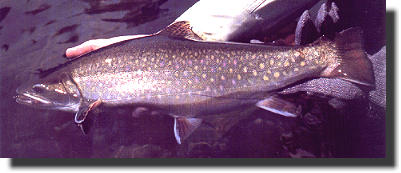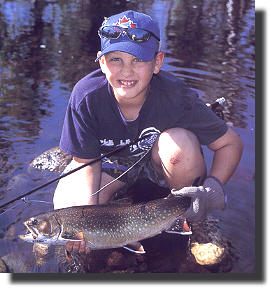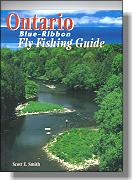Blue Ribbon Fly Fishing in Ontario, Part 2
Coastal Treasures
By Scott E. Smith
Excerpt from: Ontario, Blue-Ribbon Fly Fishing Guide
Published by: Frank Amato Publications, Inc.
P.O. Box 82112, Portland Oregon 97282 Phone: 503-653-8108,
email Frank Amato Publications
Considering that approximately three-quarters of Ontario's immense
border is either the coast of Hudson Bay and James Bay, or the shoreline
of four of the Great Lakes, a great deal of the available fly fishing in the
province is within the catchment tributaries of these bodies of water.
Numerous species of game fish and bait fish inhabit these waters. The
significant species for the fly angler are of course the salmonids, both
resident and migratory.

Within the tributaries of Hudson Bay and James Bay - part of
the Arctic Ocean - the premier species for the fly anglers is the brook
trout. Actually a char (Salvelinus fontinalis), the
brook trout in these rivers and streams are generally large and generally
easy to take on a fly. In many of the long and large tributaries, such
as the Winisk River, it is difficult to know whether or not the brook
trout are resident or migratory (from Hudson Bay). It is generally
felt that most spawning voyages of oceanic brook trout are not lengthy.
Subsequently, if you are only miles from the salt, you may be indeed
fishing over migratory brook trout.
"Brookies," the nickname for brook trout, does not seem to suit
these specimens that often attain weights of five to eight pounds. A
brook trout of this size demands respect and is a sight to behold,
especially when adorned in fall colours. Few fish are as precious as
the brook trout.
The brook trout in these tributary streams are totally wild.
No stocking programs, no genetic tinkering: pure, wild fish.
Almost the entire southern border of Ontario is defined by the
shores of four of the Great Lakes: Lake Superior, Lake Huron,
Lake Erie and Lake Ontario. In contrast to the Hudson Bay and
James Bay fishery, most of the salmonids pursued by anglers - except for
wild brook trout and lake trout - were introduced around the turn of
the last century. Steelhead, which thrive in all of the lakes, are the
most sought-after species by the fly fisher. Although stocking programs
still enhance the populations of steelhead in the lower Great Lakes, they
have adapted to their respective regions and have become self-sustaining.
On the Ontario shore of Lake Superior no stocking of steelhead has been
done since the turn of the century. Subsequently, these fish are now
considered wild and fight appropriately.

The fly anglers that frequents Ontario's Great Lakes tributaries will
encounter numerous species of salmonids, including: Steelhead
(migratory rainbow trout), Atlantic salmon, lake trout, brown trout,
brook trout, and three species of Pacific salmon: Coho, Chinook
and pink. In addition, many of these streams host resident
populations of rainbow, brook and brown trout, as well as a number
of warmwater species.
Having said all that, the successful fly anglers must still know which
tributaries host which species of fish - and when. This is where the
advantages of networking and the keeping of an accurate fishing log
come into play. The fly angler must also know the the techniques, flies
and lies, in order to be successful.
Subsequently, when fishing Ontario's coastal streams it is always wise
to hire a guide. In face, when fishing certain wilderness rivers, to not
hire a guide would be remiss, even foolhardy. Many anglers have
travelled considerable distances and invested considerable fishing time
only to find later that they had been fishing above a barrier to migratory
fish, or fishing water that was otherwise barren for a number of varied
reasons. These scenarios can be avoided easily with the employment of
a reputable guide.
It is always prudent - whether you're guided or not - to ensure that you are
fully aware of the fishing regulations applicable to the water you are
fishing, and to abide by them.
 Next time Techniques for Coastal Waters! ~ Scott E. Smith
Our Man In Canada Archives
Next time Techniques for Coastal Waters! ~ Scott E. Smith
Our Man In Canada Archives
|



